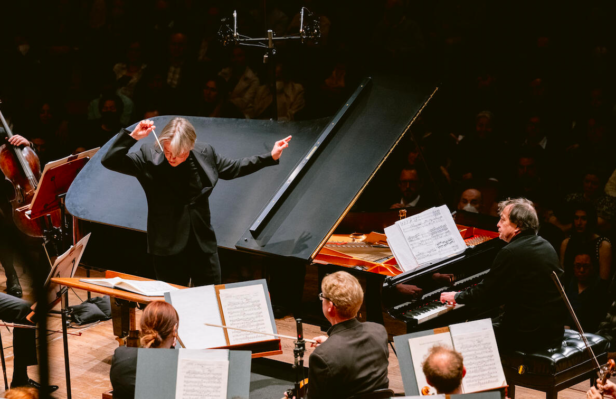 United States Ravel, Bartók, Prokofiev: Pierre-Laurent Aimard (piano), San Francisco Symphony / Esa-Pekka Salonen (conductor). Davies Symphony Hall, San Francisco, 17.2.2023. (HS)
United States Ravel, Bartók, Prokofiev: Pierre-Laurent Aimard (piano), San Francisco Symphony / Esa-Pekka Salonen (conductor). Davies Symphony Hall, San Francisco, 17.2.2023. (HS)

Ravel – Le tombeau de Couperin
Bartók – Piano Concerto No.2
Prokofiev – Selections from Romeo and Juliet
A fascinating aspect of San Francisco Symphony’s current season is the opportunity for audiences to hear how Esa-Pekka Salonen approaches pieces that were touchstones for his predecessor as music director for 25 years, Michael Tilson Thomas. The latest – the much-loved music from Prokofiev’s Romeo and Juliet ballet – proved to be a revelation.
As the program notes pointed out, conductors often mix and match movements from Prokofiev’s three suites to concoct their own assemblages. Tilson Thomas and his predecessors in San Francisco – notably Seiji Ozawa and Edo de Waart – did so, following their own muses. Whatever Tilson Thomas came up with – and he programmed this music often – it favored Prokofiev’s bold rhythms and heart-on-sleeve romanticism.
Salonen’s take included most of the big moments, starting with the contrast between the galumphing rhythms of the ‘Dance of the Knights’ in ‘Montagues and Capulets’, and the deftly skittering bustle of ‘The Young Juliet’ preparing for the ball. Prokofiev, notably didn’t include either until his Suite No.2, but they are now among the most popular excerpts from the ballet. Salonen mixed these familiar moments with lesser-heard scenes, most appealingly with the gentle ‘Morning Dance’ and the gloriously plush ‘Aubade’ (both from Suite No.3).
His sense of rhythm struck me as more measured than that of Tilson Thomas, especially in the heavyweight strutting dance from the early scene. The softer sections glowed with a warmer light, and it all balanced marvelously.
Salonen relished the kaleidoscope of textures and colors in Prokofiev’s score, especially in the broadly graceful ‘Minuet’ and sharper ‘Mask’ from the ball scene, prominently featured in Prokofiev’s first suite. A short version of the balcony scene (‘Romeo and Juliet’) created a hopeful feeling. Later, in ‘Romeo at the Fountain’ (which Prokofiev used to open the third suite), the conductor conveyed an undertow of worry in a picture of the character greeting a sunny morning early in the ballet.
This led nicely to the ‘Death of Tybalt’, a mainstay of most ad hoc suites for its long crescendo from playful to menace in a scene pivotal to the story’s plot. Like Tilson Thomas, Salonen can conjure up a musical build-up that shakes our bones, and he did.
Following that with the sweet morning-music of ‘Aubade’ was a nice stroke, the beginning of a downward side of the arc: the soft sadness of ‘Romeo at Juliet’s Grave’ (which ends Prokofiev’s second suite) and then, finally, ‘Death of Juliet’ (which ends the third suite). The result was a sweeping narrative from the fizziness of ‘The Young Juliet’ to the climax of Tybalt’s death and back down to the tragic ending’s gentle musical language.
Although the orchestra has been promoting the concert with the Prokofiev, on my calendar I had tagged it for Bartók’s Piano Concerto No.2, with the much-admired pianist Pierre-Laurent Aimard at the keyboard. Known for his work in music by Ligeti, Boulez and Messiaen, Aimard should have mined all the raucous details of Bartók’s insanely difficult concerto.
Unfortunately, not quite. Although he played the music stylishly, the first movement never seemed to get in sync rhythmically with Salonen and the orchestra (which, aided by bumptious percussion, danced merrily). At times Aimard was a tad behind Salonen’s beat, sometimes ahead of it. The result was a sense of unease rather than momentum. The Adagio was better, where the piano became more expressive in the decorated slow-scale figures. The movement’s Presto central section, though, lurched awkwardly.
The concerto is being recorded for future release. Let us hope the other two performances on the schedule have got the beat together.
Ravel’s homage to eighteenth-century French music, Le tombeau de Couperin, opened the concert in a performance that featured some beautiful playing by principal oboe Eugene Izotov. For his part, Salonen, conducting without a baton, elicited soft-edged sound without losing essential rhythms. Somehow, he shaped it as a gauzy Ravel creation rather than the faux-Baroque performances we often hear.

When the orchestra came on stage for the Prokofiev, all together in European-style instead of warming up and practicing as usual, the musicians acknowledged the audience’s applause by holding up green-tinted paper handouts to explain their side of ongoing contract negotiations. They have been negotiating their contract since September and agreed to a pay cut during the pandemic. In a program insert, management spelled out its current offer in detail.
Harvey Steiman
